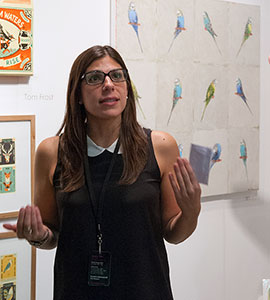Cristina Salmastrelli ’05
Dedicated to putting art within reach of everyone, Cristina Salmastrelli ’05 directs the Affordable Art Fair New York City. Having majored in art and art history and history at Colgate, she has a master’s in museum studies from New York University. She believes fairs provide a place where galleries and collectors can exchange ideas and learn. For the novice, buying art can be daunting, so here are her ideas for building a collection you can be proud of.
Be fair. Art fairs are a great place to get acquainted with the art world because you have a large range. When there isn’t a fair going on in your city, tour local galleries. Get involved in the art scene and go to openings. Look online at art websites and blogs; sign up for art newsletters. Another great tool is Google alerts. To keep up to date, I have Google alerts for different art categories, including “contemporary art NYC,” “international art fairs,” and “photography.”
 Prepare. Before you step into a fair with numerous pieces on display, have a sense of what you might be looking for. First, figure out what type of art you like. Go online, research genres of art, and find the ones that are your favorites. Take note of what you’re drawn to. Next, figure out where you want to place art in your home. Never forget about the bathroom! That’s where you can put the funkiest pieces. Once you’ve settled on where, measure and write down the dimensions.
Prepare. Before you step into a fair with numerous pieces on display, have a sense of what you might be looking for. First, figure out what type of art you like. Go online, research genres of art, and find the ones that are your favorites. Take note of what you’re drawn to. Next, figure out where you want to place art in your home. Never forget about the bathroom! That’s where you can put the funkiest pieces. Once you’ve settled on where, measure and write down the dimensions.
Take your time. Take a lap around the fair or gallery and think about any pieces you are contemplating buying. Snap photos if you can get permission from the gallerist, and if you can, even go home and sleep on it. Or, at least chat with a friend, take a coffee break, or get some food. There is no need to buy impulsively. Build your collection slowly with careful consideration, piece by piece. You should feel comfortable when you make your purchase. If it takes time, the gallery should understand that. Likewise, don’t feel intimidated. There is art for every budget.
Ask questions. Get as much information as you can. Ask questions — the answers will help you feel more comfortable with your purchase. Then when it’s hanging in your house, you can tell your friends and family about the background, the artist’s inspiration, and the reason you wanted it. My favorite questions are: “How long did it take the artist to make this piece?” “What influenced the artist to create this work of art?” “Is this different than what the artist has done in the past?” and “Why did you as a gallerist choose to represent this artist?”
Buy a piece for love — and love only. The true investment when purchasing a piece of art is the joy it brings you every day when you see it in your personal space. Don’t worry about what anyone else will say about it. If it brings you joy, stick with your gut and go for it. Self-discovery is one of the best rewards when buying art.
Editor’s note: reprinted with permission from Salon.com






